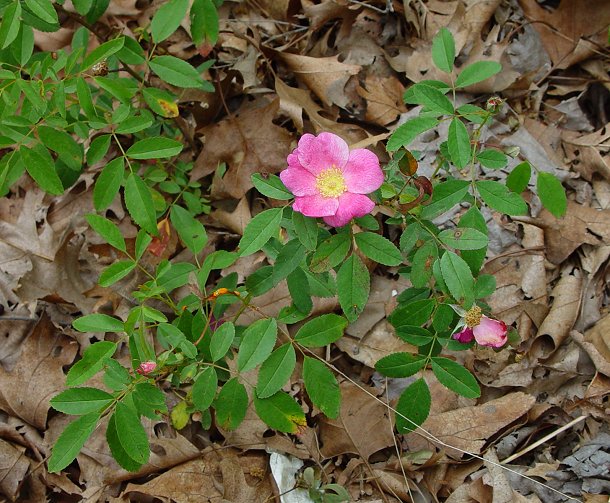Rosa carolina L.
Pasture Rose

Native
CC = 4
CW = 3
MOC = 99
© DETenaglia
Rosa carolina L.Pasture Rose | |
 |
Native CC = 4 CW = 3 MOC = 99 |
© DETenaglia |
|
Family - Rosaceae Habit - Low shrub. Stems - Low or weak and spreading to strongly ascending, to 1 m, mostly slender, dull reddish brown, the relatively few branches with mostly paired prickles at the nodes, these 3-9 mm long, 1.5-3.0 mm wide, sometimes slightly to moderately broadened at the base, straight, occasionally downward-angled or rarely curved, flattened or not, sometimes also with sparse, scattered bristles between the nodes, rarely unarmed or densely covered throughout with larger prickles at the nodes and shorter prickles, bristlelike prickles, and stalked glands between the nodes.
Leaves - Alternate, odd-pinnate, stipulate. Leaves 5-10 cm long, the petiole and rachis glabrous or less commonly hairy, occasionally with sparse stalked glands, occasionally with small prickles and/or scattered bristles. Stipules 10-18 mm long, the margins entire or finely glandular-toothed toward the tip, the auricle flared, 2-4 mm long. Leaflets usually 5 or 7, 18-50 mm long, 9-28 mm wide, the terminal leaflet with a stalk 4-11 mm long, the blades ovate, elliptic, or lanceolate, angled at the base, angled or tapered at the sharply or occasionally bluntly pointed tip, the margins relatively coarsely and usually simply toothed with 8-14 teeth per side, these sometimes gland-tipped, the upper surface dull or slightly shiny, green, the undersurface glabrous or rarely hairy or glandular on the midvein.
Inflorescences - Inflorescences on lateral branches from second year's stems, of solitary flowers or less commonly clusters of 2-3 flowers, the flower stalks 5-19 mm long, with few to many stalked glands, rarely nonglandular, with usually several bracts. Flowers - Fragrant. Hypanthium 4-6 mm long, with sparse to dense stalked glands, rarely nonglandular, the mouth usually 1.5-2.0 mm in diameter. Sepals 16-22 mm long, 3-4 mm wide, often unequal, some of them usually extending into dilated, somewhat leaflike tips and with the margins toothed or with 1 or few pairs of linear lobes, the undersurface nonglandular or occasionally sparsely glandular, becoming reflexed after flowering, usually shed by fruit maturity. Petals 5, 15-24 mm long, spreading, pink to less commonly reddish pink, rarely white. Stamens numerous. Filaments yellow, glabrous, to 8 mm long. Anthers yellow, to 3 mm long. Pistils 32-46, the styles free, hairy, not extending or extending up to 1 mm beyond the mouth of the hypanthium, the mass of stigmas thus not or only slightly elevated, more or less closing the hypanthium mouth.
Fruits - Hips 7-14 mm long, 6-15 mm wide, globose to slightly depressed-globose or rarely ellipsoid, fleshy, the surface dull to more commonly shiny, red to orangish red, lacking glands or with sparse to dense stalked glands. Achenes mostly 2-6 (note additional presence of up to 16 undeveloped ovaries), 4-5 mm long. Flowering - May - June. Habitat - Prairies, sand prairies, forest openings, savannas, glades, ledges and tops of bluffs, streambanks, levees, swamps, pastures, fields, fencerows, cemeteries, railroads, and roadsides. Origin - Native to the U.S. Lookalikes - Other species of Rosa, especially R. arkansana. Other info. - This is a common species found throughout Missouri and probably the most common wild rose in the state. It is also common across the eastern half of the continental U.S., also ranging into Canada. The plant is easily recognized as a rose from the general appearance of the flowers, the pinnate leaves with toothed leaflets, and of course the prickly stems. However, Missouri is home to several species of wild rose, and differentiating between them can be difficult. Among other things, R. carolina is recognized by having mostly 5 or 7 leaflets per leaf, stalked glands on the hypanthium, and no stylar column in the center of the flower. This last attribute can be compared with the case of R. setigera, which does have a stylar column. Photographs taken in the Ozark Scenic Riverways, Shannon County, MO., 5-23-03 and 5-31-03 (DETenaglia); also at Shaw Nature Reserve, Franklin County, MO, 5-27-2015, and Tingler Prairie Natural Area, Howell County, MO, 6-10-2021 (SRTurner). |